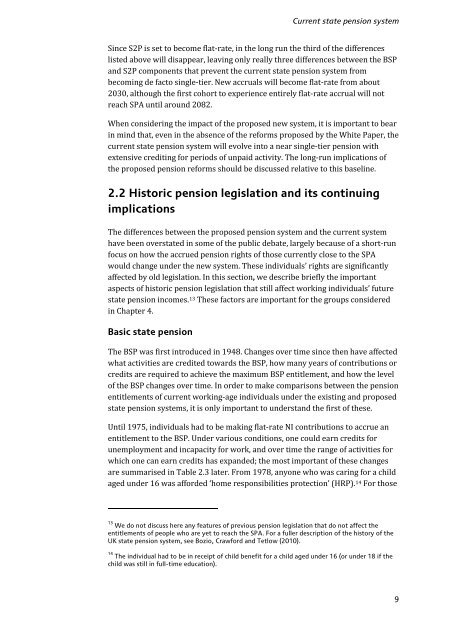A single-tier pension: what does it really mean? - The Institute For ...
A single-tier pension: what does it really mean? - The Institute For ...
A single-tier pension: what does it really mean? - The Institute For ...
You also want an ePaper? Increase the reach of your titles
YUMPU automatically turns print PDFs into web optimized ePapers that Google loves.
Current state <strong>pension</strong> system<br />
Since S2P is set to become flat-rate, in the long run the third of the differences<br />
listed above will disappear, leaving only <strong>really</strong> three differences between the BSP<br />
and S2P components that prevent the current state <strong>pension</strong> system from<br />
becoming de facto <strong>single</strong>-<strong>tier</strong>. New accruals will become flat-rate from about<br />
2030, although the first cohort to experience entirely flat-rate accrual will not<br />
reach SPA until around 2082.<br />
When considering the impact of the proposed new system, <strong>it</strong> is important to bear<br />
in mind that, even in the absence of the reforms proposed by the Wh<strong>it</strong>e Paper, the<br />
current state <strong>pension</strong> system will evolve into a near <strong>single</strong>-<strong>tier</strong> <strong>pension</strong> w<strong>it</strong>h<br />
extensive cred<strong>it</strong>ing for periods of unpaid activ<strong>it</strong>y. <strong>The</strong> long-run implications of<br />
the proposed <strong>pension</strong> reforms should be discussed relative to this baseline.<br />
2.2 Historic <strong>pension</strong> legislation and <strong>it</strong>s continuing<br />
implications<br />
<strong>The</strong> differences between the proposed <strong>pension</strong> system and the current system<br />
have been overstated in some of the public debate, largely because of a short-run<br />
focus on how the accrued <strong>pension</strong> rights of those currently close to the SPA<br />
would change under the new system. <strong>The</strong>se individuals’ rights are significantly<br />
affected by old legislation. In this section, we describe briefly the important<br />
aspects of historic <strong>pension</strong> legislation that still affect working individuals’ future<br />
state <strong>pension</strong> incomes. 13 <strong>The</strong>se factors are important for the groups considered<br />
in Chapter 4.<br />
Basic state <strong>pension</strong><br />
<strong>The</strong> BSP was first introduced in 1948. Changes over time since then have affected<br />
<strong>what</strong> activ<strong>it</strong>ies are cred<strong>it</strong>ed towards the BSP, how many years of contributions or<br />
cred<strong>it</strong>s are required to achieve the maximum BSP ent<strong>it</strong>lement, and how the level<br />
of the BSP changes over time. In order to make comparisons between the <strong>pension</strong><br />
ent<strong>it</strong>lements of current working-age individuals under the existing and proposed<br />
state <strong>pension</strong> systems, <strong>it</strong> is only important to understand the first of these.<br />
Until 1975, individuals had to be making flat-rate NI contributions to accrue an<br />
ent<strong>it</strong>lement to the BSP. Under various cond<strong>it</strong>ions, one could earn cred<strong>it</strong>s for<br />
unemployment and incapac<strong>it</strong>y for work, and over time the range of activ<strong>it</strong>ies for<br />
which one can earn cred<strong>it</strong>s has expanded; the most important of these changes<br />
are summarised in Table 2.3 later. From 1978, anyone who was caring for a child<br />
aged under 16 was afforded ‘home responsibil<strong>it</strong>ies protection’ (HRP). 14 <strong>For</strong> those<br />
13 We do not discuss here any features of previous <strong>pension</strong> legislation that do not affect the<br />
ent<strong>it</strong>lements of people who are yet to reach the SPA. <strong>For</strong> a fuller description of the history of the<br />
UK state <strong>pension</strong> system, see Bozio, Crawford and Tetlow (2010).<br />
14<br />
<strong>The</strong> individual had to be in receipt of child benef<strong>it</strong> for a child aged under 16 (or under 18 if the<br />
child was still in full-time education).<br />
9

















